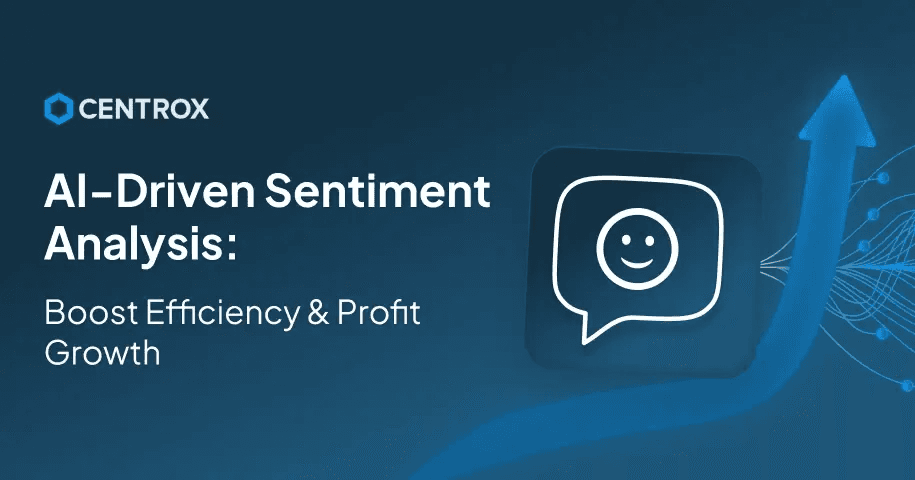AI-Driven Sentiment Analysis: Driving Efficiency and Profit Growth
Learn how AI sentiment analysis is transforming business process efficiency, find its working mechanism, application, and its future potential.
8/1/2025
artificial intelligence
9 mins

Understanding the behavioral patterns of users is very critical for enabling businesses to align their business strategies according to users' interests. Businesses nowadays are in constant search for ways they build a competitive edge over others. An AI-driven sentiment analysis tool can serve as a single solution that contributes to perceiving the underlying user interest, helping in tailoring customized strategies that are adjusted according to user preference.
In today's market, building a quality product is just not enough to thrive. To secure your place in the user market, you need to make user-first products that are customized according to their sentiment and choice patterns.
With our guide, we will help you learn what AI-driven sentiment analysis is, how AI specifically works for performing sentiment analysis, and what further AI-powered revolution we can anticipate for sentiment analysis applications.
What is AI-driven sentiment analysis?
AI-driven sentiment analysis basically utilizes AI models, natural language processing, and machine learning models to automatically identify, understand, interpret, and classify emotions or opinions expressed in the provided text, which could be reviews, social media posts, surveys, emails, or chats.
Significance of AI-powered sentiment analysis
In recent times, we have been observing that customers prefer fast, reliable, affordable, and quality products or services. Making the right combination of all these parameters in your product or service might sound very unrealistic, but now the AI-powered tool is introduced to amaze you with its advanced ability to perform sentiment analysis. With a sentiment analysis tool, it understands the complex underlying behavioural, preferences, and desire patterns of the users from the provided text, like reviews, posts, or chats. By analyzing these patterns, such tools can generate tailored strategies that could be used to target specific customers' needs. This helps businesses in having an approach that requires fewer resources and costs, and is more intelligent for streamlining strategies.
As Demis Hassabis (CEO, DeepMind) says:
"AI will be the ultimate tool for unlocking human potential."
This highlights that generative AI in sentiment analysis is allowing businesses to think beyond basic analytics and tap into the true preferences and needs of their customers, creating more meaningful and efficient strategies.
How do AI models perform sentiment analysis?
Tech experts are working closely to push the boundaries of AI and introduce new advancements every day. Sentiment analysis through AI-driven models is one such advancement. By learning about how AI model works for sentiment analysis, businesses can customize a solution that helps them stay ahead. Here's a breakdown of how it works:

1. Data Ingestion
So, the process for sentiment analysis begins with collecting the data, which could be from any source, like customer reviews, social media posts, support chats, or surveys. Then the collected data is taken as input for a generative AI model. Also, the ability of the model to interpret and understand sentiments depends a lot on the diversity and cleanliness of the data. Therefore, this step has a greater impact on solutions output.
2. Contextual Understanding
Contrary to traditional AI models, these generative AI models can better understand the full context, grammar, and nuance. By identifying the tone, emotion, sarcasm, and even cultural or situational subtleties, it helps in a more human interpretation of the hidden sentiments within the text.
3. Prompt Engineering or Fine-Tuning
After building the contextual understanding of the input text, the next important step is prompt engineering and fine-tuning the model. Through prompt engineering, we help the model to perform particular tasks like labeling sentiment or summarizing emotional tone. For further refining the model outcomes, it fine-tuned labeled datasets for domain-specific sentiment classification. With this step, we can ensure higher accuracy for specific use cases where it is implemented.
4. Generation of Insights
Finally, after prompt engineering and fine-tuning, we can evaluate the solution's performance for the sentiment analysis use case. For this, we can check if the developed AI solution doesn’t just tag sentiment, it explains why the sentiment exists or what to improve in the product or service. This may generate summaries, feedback trends, or even strategic suggestions, allowing businesses to make more farsighted decisions based on emotional data. This allows businesses to make proactive decisions based on emotional data.
5. Integration
The insights are fed into dashboards, CRMs, chatbots, or decision systems through APIs. This enables automated workflows, alerts, and real-time monitoring of customer emotions. It closes the loop from analysis to action within the business ecosystem.
Industry Application of AI Sentiment Analysis
AI-driven sentiment analysis can prove to be very empowering for business applications. Through such AI-based integration, businesses can monitor brand perception among users and accordingly strategize to make more emotionally intelligent decisions that drive growth for them. For your help, we have listed some industry applications that AI sentiment analysis is enabling:

1. Social Media Monitoring for Brand Perception
Businesses today are using sentiment analysis tools to monitor public opinion across platforms like Twitter, Instagram, and Facebook. This helps them in building brand reputation by tracking campaign performance and identifying crises early.
Example: big companies like Coca-Cola and Nike also use social media sentiment tools to fine-tune their marketing strategies and respond to customer sentiment in real time.
2. Financial Market Analysis
For applications like financial market analysis, sentiment analysis can be applied to financial news, social media, and investor discussions. This contributes to finding out market trends and informing trading decisions.
Example: Bloomberg and JP Morgan utilize AI-driven sentiment systems to understand and analyze investor mood and predict market volatility based on news sentiment and public chatter.
3. Customer Feedback Analysis in E-commerce
Another application where AI sentiment analysis integration can prove to be revolutionary is in online retailers. With such a tool, we can analyze reviews, support chats, and product ratings to improve offerings and personalize customer experience.
Example: Amazon and Walmart have this AI sentiment analysis integration that allows them to identify common complaints, improve product listings, and enhance customer satisfaction through insights from review sentiment.
Future of AI in Sentiment Analysis
The future world is going to be faster-paced, advanced, and innovative than ever. The future application of AI sentiment analysis will be beyond just the classification of sentiments in product reviews and social media monitoring. With all the relevant effort being made in this direction, we can see AI sentiment analysis reshaping how we understand human emotions across sectors, unlocking powerful insights in mental health, customer experience, and public sentiment.

1. Mental Health Monitoring & Support
- Impact: In the future, AI will be able to detect emotional distress or early signs of mental health issues through analysis of texts, chats, or voice data, which will help in extending timely intervention and support.
- Challenge: But the main challenge here would be ensuring data privacy and ethical use of sensitive emotional information, specifically in the healthcare sector.
2. Real-Time Customer Emotion Tracking in Voice Calls
- Impact: The AI will be allowing the business to assess customer emotions during live calls, which will enable the agents to be more empathetic and adaptive to real-time changes.
- Challenge: Being able to accurately identify the sentiment in different accents, tones, or languages can be a challenging job and may lead to misinterpretation if not properly localized or trained. (Abdelrahman et al., 2023)
3. Political & Social Trend Forecasting
- Impact: Also, in the future, governments and organizations can utilize AI sentiment analysis to track public opinion and predict emerging social or political trends by analyzing large-scale online discourse.
- Challenge: The bias present in training data or manipulation through bots and fake accounts can corrupt the sentiment analysis, eventually making misleading forecasts or actions.
4. Personalized Learning in Education
- Impact: With a sentiment analysis integrated solution, we can have EdTech platforms that tailor content according to students' level of understanding, and make it more convenient.
- Challenge: Misreading emotions could lead to inappropriate content adjustments or overlooked learning gaps.
5. AI-Powered Job Recruitment & HR Insights
- Impact: Recruiters will use sentiment analysis on candidate communications and interviews to gauge enthusiasm, cultural fit, and honesty.
- Challenge: A key limitation of sentiment analysis is its susceptibility to bias, with over 75% of systems studied using the Equity Evaluation Corpus showing gender or race bias, which raises ethical concerns around fairness, transparency, and bias in candidate evaluation. (Svetlana et al., 2018)
6. Brand Health & Crisis Management
- Impact: Companies will use AI to continuously monitor brand sentiment in real time, allowing immediate response to PR crises or product backlash.
- Challenge: Requires distinguishing between temporary noise and meaningful sentiment shifts to avoid overreaction.
The Final Takeaway
AI-driven sentiment analysis is opening doors to a new avenue by introducing transformative applications for mental health, education, customer service, politics, and beyond. With its impressive ability to interpret human emotion at scale, it enables more personalized, timely, and effective interactions.
But with all the advantages, the real challenge that serves as a hindrance is ensuring data privacy, bias, and ethical deployment. So in order to make the most out of this advanced innovation, organizations should consider investing in ethically designed models, diverse training data, and interdisciplinary collaboration. Additionally, regular audits and user feedback loops can also play a critical role in refining accuracy.
By applying these practices, sentiment analysis can move from a supportive tool to a strategic driver of empathy, insight, and smarter decision-making across industries.
Feeling disconnected from your audience due to unclear behavioral patterns? AI-powered sentiment analysis can bridge that gap. Connect with our experts at Centrox AI and unlock deeper business intelligence today.

Muhammad Harris
Muhammad Harris, CTO of Centrox AI, is a visionary leader in AI and ML with 25+ impactful solutions across health, finance, computer vision, and more. Committed to ethical and safe AI, he drives innovation by optimizing technologies for quality.
Do you have an AI idea? Let's Discover the Possibilities Together. From Idea to Innovation; Bring Your AI solution to Life with Us!
Your AI Dream, Our Mission
Partner with Us to Bridge the Gap Between Innovation and Reality.
